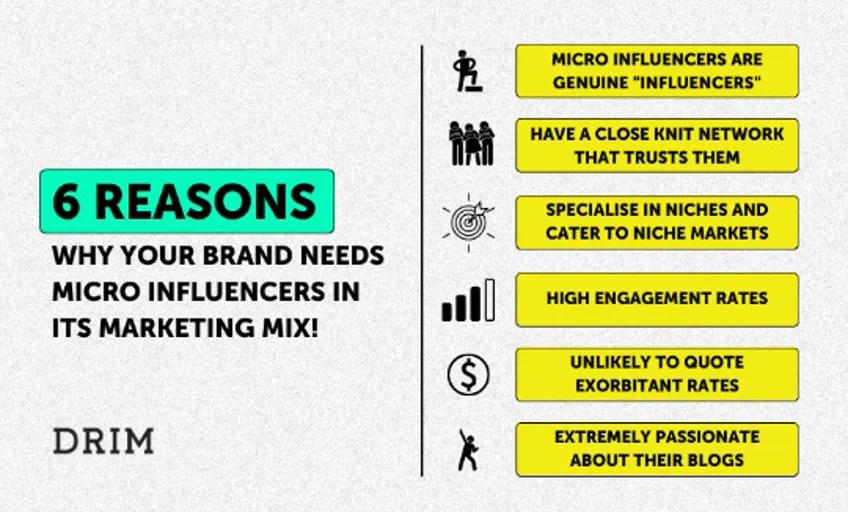
Imagine being constantly bombarded with the same set of celebrities endorsing products. After a while, it all starts appearing the same.
That’s exactly what consumers are going through these days – being bombarded with tons of promotional content across traditional and social media. It’s no surprise that they are tired of all the “noise”.
This is where influencers come in.
And no, we’re not talking about celebrity influencers with a humongous follower count. The context revolves around micro influencers, who help brand managers strike gold by cutting through the endless noise across social media platforms.
92% of customers trust a micro-influencer more than a traditional ad or an endorsement from celebs.
So, who are these micro influencers?
Micro Influencer definition
We often get queries from brands that revolve around the meaning of micro influencers
Micro influencers are influencers whose follower count ranges between 5,000 - 20,000.
While the audience size of these influencers is way bigger than the nano influencers, they are still relatable to the followers, with good engagement rates. One caveat here is that these influencers often target a specialized niche, which is great news for brands that want to achieve focused sponsorships.
Who can benefit from micro influencer marketing?
Do all brands stand to benefit from micro influencer marketing strategy? The answer is yes.
As long as your audience is active online on social media channels which you want to target, this is one of the failsafe ways to gain their attention, penetrate the market and capture the consumer base.
When planned elaborately, the strategy will ensure that your brand makes the most of the opportunity at times when your target audience is online. And this applies to both B2C and B2C brands.
It doesn’t matter which industry the brand belongs to as there’s a long list of micro influencers who cater to brands across varied industries.
How do micro influencers help brands better than influencers with big audiences?
Influencer marketing is a different ball game altogether courtesy endless agencies, platforms, and even full-fledged marketplaces available at brands’ disposal. The ask however, remains the same – why even work with a nano and micro influencer than directing the marketing spend on macro influencers and celebrities?
There are a few reasons.
#1 They are more authentic
People may love to keep up with the Kardashians, but they are more likely to pay at least equal (if not more) attention to micro influencers. Imagine a scenario where Kendall Jenner endorses a certain shoe brand as a part of paid promotion tactic. In this situation, the content may come out like she’s trying too hard to sell.
While it may do the trick for ardent followers, people would base purchase decisions on trust. The latter is provided by someone who’s passionate at what they do, particularly the content they create.
Question yourself – would you buy a pizza from a place that’s suggested by a local food influencer who posts regularly or opt for the one endorsed by a celebrity who endorses 10 different things? You got your answer right there, and so do brands!
#2 They have established a trusted network
Going by the definition, nano/micro influencers have a comparatively smaller follower count as opposed to macro influencers and celebrities. To their advantage, this follower base is built on a foundation of trust over time.
How did they arrive at that? By consistently posting content that they are passionate about. This is what people love to consume and appreciate instead of relentless sponsored content and random postings. At the same time, they keep interacting with the audience, forming genuine connections and trusted values.
In short, they keep it real.
#3 They cater to niche markets
Are you a brand that serves customers in specific niches? If your answer is affirmative, then micro influencers are your best bet. Because unlike celebrities or macro influencers, micro influencers are often associated with niche market segments.
Even there, there is a neat segregation. For example, one food influencer will only promote street food, while another will focus on world cuisine. This gives brands the choice to serve personalized content and present choices to their targeted audience.
Think – what sort of people does your audience follow? What’ll encourage them to purchase your product? What motivates them on a regular basis? What is the type of content they consume the most?
Micro influencers guarantee 22.2 times more conversations than a typical user.
The reason - they serve personalized content based on a particular niche.
#4 They have high engagement rates
Since they have a tight knit community of followers who they network with regularly, nano or micro influencers have comparatively higher engagement rates.
Sample a scenario where a mom influencer talking about a new brand of diaper she found at a supermarket gets queries directed about the product. Ideally, she would reply to all the DMs or comments, or at the most put a story or another post addressing the queries collectively.
In brief, closing the loop with fans and followers leads to insanely high engagement.
#5 They don’t charge an exorbitant rate
While macro influencers and celebrities may propel brands to greater visibility, the ground reality is that they are super expensive to work with. This is why only huge brands or big-ticket enterprises/organizations can afford to work with celebrities.
As a brand that’s just testing the waters, the best resort is to go with the nano or micro influencers. More often than not, they will be okay to work on a cost-per-action model, wherein they will get paid based on how their posts perform/the results of their posts and not just for the content they keep churning out.
It’s a win-win situation for both the brand and the influencer in this case.
#6 Their passion takes care of everything
Nano and micro influencers come with a contagious zest for the things they talk about. For them, nothing comes closer than creating content and providing authentic information for their target audience segment.
Think of makeup enthusiasts reviewing and recommending the best products to opt for Christmas. The ulterior motive is to share free content that benefits their follower base and this is what keeps them going. In this situation, their posts guarantee more interest than a celebrity endorsing a particular brand of makeup at random.
Nano/micro influencers simply want to do better each day, perfecting the craft of conveying information in an amazing manner. Everything else just falls in place after that. All brands need to do is leverage their content.
Where to find the best micro influencer for your marketing campaign?
Finding the best micro influencer is akin to finding a needle in a haystack – because there are so many!
It’s one thing to identify and zero-in on the right nano and micro influencer for your brand. The challenge is not knowing where to look. With an overwhelming number of influencers and choices, brands end up landing in chaos. This is where the influencer campaign comes tumbling down.
So, how do you find the best micro influencers for your brand?
- Craft a stellar influencer marketing strategy. Nothing works until you have a clear roadmap of what you want to accomplish by roping in the micro influencers. This is where you need to outline the best micro influencer marketing strategy that does the job for you.
- Find the best micro-influencers – With no shortage of micro influencers on the market, you need to figure out who are the best of the lot and will help you leverage the marketing campaigns. You can check DRIM’s database of micro influencers to get insights about various influencers and take a pick. The other, slightly longer method is to conduct a thorough research and figure out the best influencers for your niche.
- Dig deeper into the insights – We already spoke about micro influencer insights on various databases. These include their target audience demographics, the kind of content they churn out, the authenticity of the followers and so on.
- Monitor their engagement rates – It’s not enough for micro influencers to just keep posting – it’s also essential to have engagement with the subscribers or followers. It is a critical metric to track before you zero in on any micro influencer and the success of your campaign will rely heavily on the same.
- Don’t just rely on one – Work with a set of influencers who can help your brands reap tremendous benefits. Nowadays, there are several influencers who also collaborate with each other to take their content to two sets of followers. By working within a broad network of micro influencers, you can also tap into this potential and enhance your brand’s visibility twice as much.
- Opt for cost per click – You can work with micro influencers on CPC or Cost Per Click model or Cost Per Post and compensate them accordingly. Alternatively, you can compensate basis the conversions or engagement they bring in via their content. No need to provide products for free
Why choose DRIM – an effective micro influencer marketing platform to find your micro influencer?
It’s no secret that finding any influencer proves costly for brands, especially the ones that want to gain quick traction. DRIM helps match brands with the best micro influencers who can carry out various promotions. This way, brands can leverage the influencers in less time and gain more traction for their business.
Select from our unique database of 1000+ managers who’ll assist you with personalized attention to scout the best influencers for your niche. They have a vast pool of over 100K nano and micro influencers to select from.
Choose DRIM and watch your brand soar. Contact us now!


